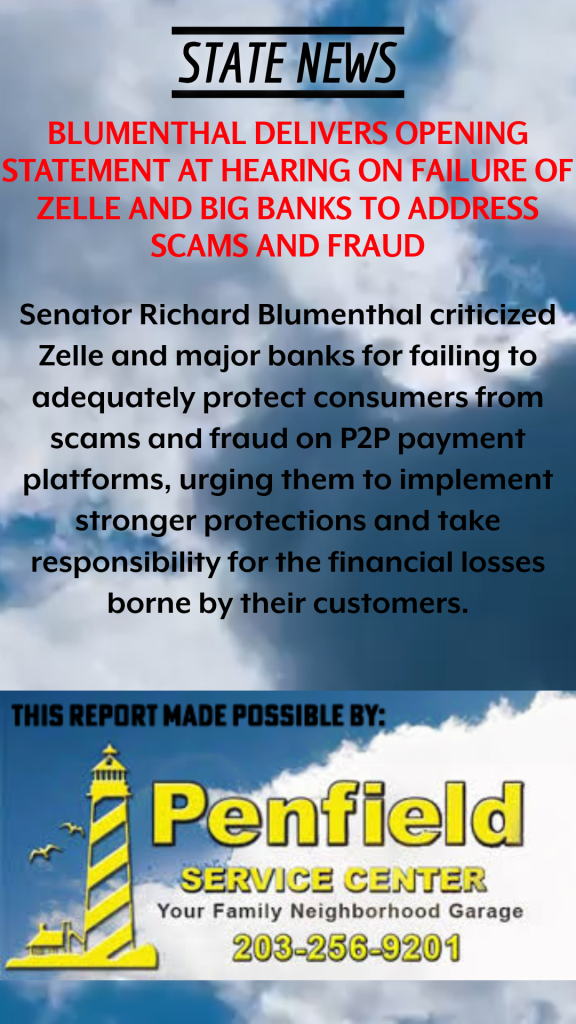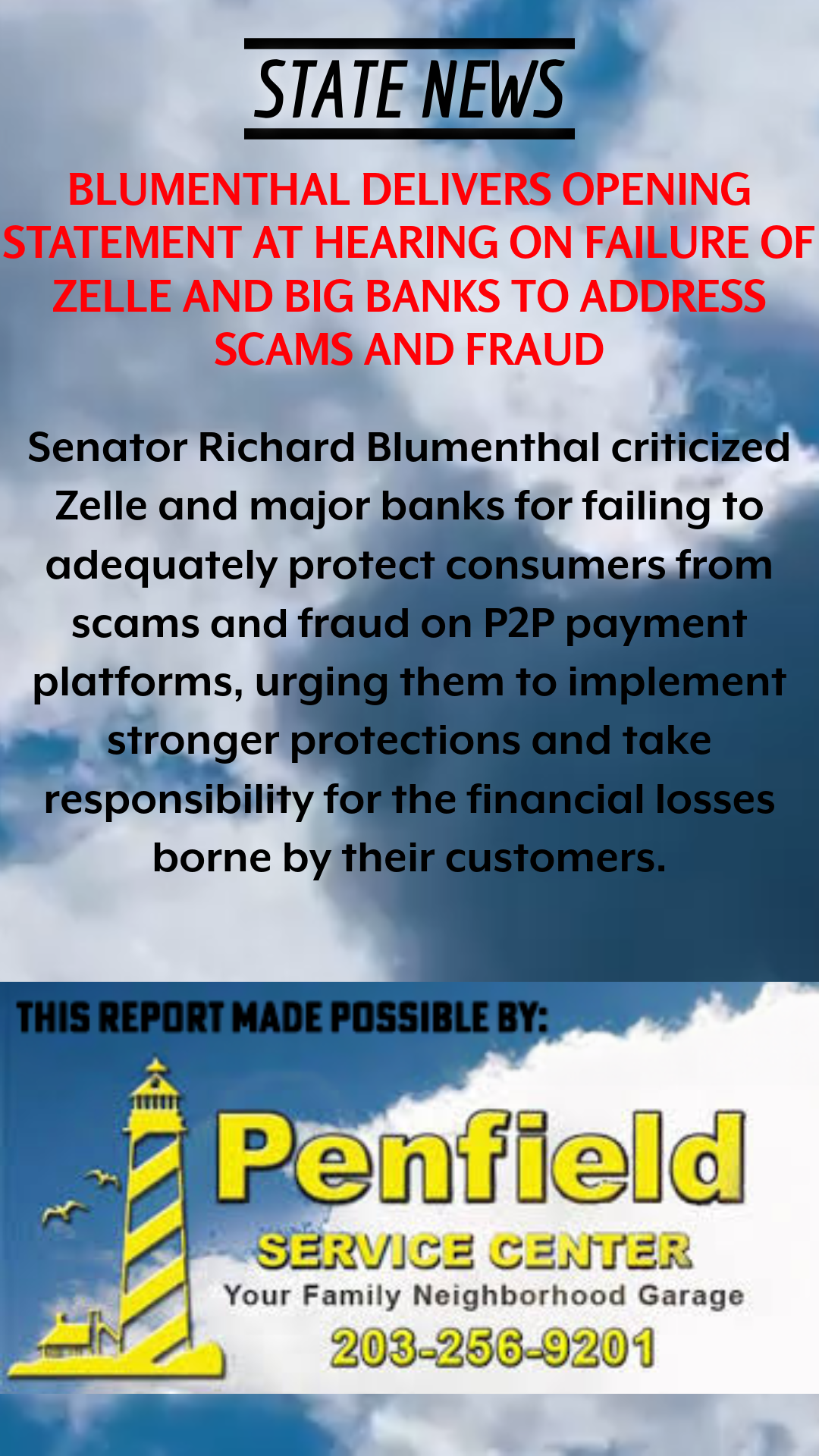“Zelle and the big banks said they couldn’t help. What they really meant is they wouldn’t help.”

[WASHINGTON, DC] – Today, U.S. Senator Richard Blumenthal, Chair of the Permanent Subcommittee on Investigations (PSI), delivered opening remarks at a hearing titled “Fraud Alert!: Shedding Light on Zelle.” The hearing—featuring testimony from two individuals who were victimized by scammers on the peer-to-peer payment (P2P) platform—examined the human toll of schemes on P2P money transfer services, the availability of and processes for consumer reimbursement of money lost to scams and fraud, and the extent of current regulatory and legal protections for consumers.
“Zelle markets itself as, ‘a fast and easy way to send and receive money.’ But as this Subcommittee has found, ‘a fast and easy way to lose money’ is often what happens on Zelle,” said Blumenthal.
Emphasizing the unique risks associated with Zelle, Blumenthal underscored the need for the platform and the banks that own it to better protect consumers, “All peer-to-peer payment apps are susceptible to fraud, no question about that fact. And I want to be clear that fraud happens on all of them, but Zelle deserves particular attention because of its direct connection to trusted financial institutions. Zelle and the banks that own it offer to customers the appearance of the trust they feel they deserve. But the risks there are real and present, and they simply are failing to protect consumers in the way that they deserve.”
Blumenthal called on Zelle and the banks that own it to do more to protect consumers, “Many types of scams exist, but what they have in common is that these stories and many other consumers entail lost money due to fraud scams. Time and again, Zelle and the big banks have said they couldn’t help. What they mean is they wouldn’t help.”
“Unfortunately, for consumers, it seems like the big banks have accepted that some of the transactions on Zelle will be fraudulent. They’ve made the decision that this is just the cost of doing business. But it’s the cost to their consumers, not them, because it’s the customer who is out of pocket. That’s why we have invited Zelle and the three largest banks to appear,” Blumenthal concluded.
Video of Blumenthal’s opening remarks can be found here. The full transcript of Blumenthal’s opening remarks can be found below.
Thank you to my Co-Chairman of the Subcommittee, the Permanent Subcommittee on Investigations—we work together on a bipartisan basis.
I am very pleased to welcome you to this hearing of the Permanent Subcommittee on Investigations, entitled “Hearing on Fraud Alert!: Shedding Light on Zelle.” And I will give an opening statement, it will be followed by Ranking Member.
The Banks of America have a dirty little secret. It’s called Zelle. And it’s not just Zelle, it’s other P2P paid platforms—apps that people use to transfer money among their bank accounts. In the case of Zelle, it is nearly instantaneous. It’s almost always irreversible. And it is owned by banks.
In fact, Zelle is the largest peer-to-peer payment app. It’s actually operated by Early Warning Services, which in turn is owned and operated by the seven largest banks. And Zelle is often integrated into consumers’ existing online bank accounts and mobile apps.
Zelle markets itself as “A fast and easy way to send and receive money.” But, as this Committee has found, “a fast and easy way to lose money” is often what happens on Zelle. And that is probably a more accurate catchphrase for Zelle and for other P2P platforms as well. What distinguishes Zelle is speed, permanence, and bank ownership, and that’s really the reason why we are focusing on Zelle, but the other platforms deserve attention as well. In fact, it’s less well known than other payment apps like Cash App and Venmo, but Zelle is by far the largest—several times its nearest competitor, and it is approximately three times larger than its nearest rival.
Zelle transfers are nearly instant and irreversible, and by the time a consumer knows they’ve been scammed, usually it’s too late to do anything about it—at least according to Zelle and according to the banks that own, control, and in effect operate Zelle.
Just three banks, J.P. Morgan, Chase, Bank of America, and Wells Fargo handled 73% of all Zelle transactions in 2023. All peer-to-peer payment apps are susceptible to fraud, no question about that fact. And I want to be clear that fraud happens on all of them, but Zelle deserves particular attention because of its direct connection to trusted financial institutions.
Zelle and the banks that own it offer to customers the appearance of the trust they feel they deserve. But the risks there are real and present, and they simply are failing to protect consumers in the way that they deserve. 13% of P-to-P platform users report sending money to someone and later realizing it was a scam. And the kinds of scams are various—me-to-me, employment, romance, AI. They have various categories. But the bottom line here is literally that the banks are failing to do what they should to protect their consumers.
This Subcommittee has heard many accounts of scams and fraud on Zelle. In California, a teenager received escalating death threats and lost $10,000 on Zelle simply because he wanted to protect his family. In Florida, criminals hacked into a woman’s bank account and used her confidential information to manipulate her into transferring almost $5,000 to Zelle scammers. In Arizona, a man used Zelle to purchase automobile parts he never received. And I would like to enter into the record a collection of news articles about Zelle scams and statements that we have received from consumers about their personal experiences with Zelle.
With us today are two individuals who have personally experienced those stories, and we thank them from their bravery and for their initiative in coming forward. Ariana Duval, a college student in North Carolina, will tell us her story in receiving an exciting summer research opportunity from a professor at her university only to learn she was out $2400 that she never had. Anne Humphreys is also here today to tell us her story, how her 94-year-old mother was scammed out of $3500 after being told that her brother had been arrested and needed bail money and how she struggled to get their bank to realize its insufficient safety measures allowed this scam to play out. Again, we thank you both.
Many types of scams exist, but what they have in common is that these stories and many other consumers entail lost money due to fraud scams. Time and again, Zelle and the big banks have said they couldn’t help. What they mean is they wouldn’t help. And their attitude has been, “Not our problem.”
Well, to the banks of America, particularly the seven that own and operate Zelle, it is your problem. You own it. Just as you own Zelle. And you have the expertise, the resources, and the obligation to make sure that you do better.
We are also going to hear from experts as part of this bipartisan inquiry into Zelle and Early Warning Services, the company that operates Zelle. And we hope to hear from the banks. We’ve actually invited them to come here in June and explain how they can do better and why they have failed to do so.
We have found that customers of J.P. Morgan, Chase, Bank of America, and Wells Fargo submitted claims reflecting a combined total of $456 million lost to scams and fraud on Zelle in one year, 2022 alone. And only a fraction were repaid, $341 million. More than two thirds of these losses were never repaid by those banks.
The growth of mobile payments shows no signs of stopping. But unfortunately, neither do the scammers who are preying on American consumers on those apps. Criminals are increasingly using scams tailored to individuals with AI voice cloning and personal details pulled from hacked data, sold on the dark web, and increasing the risk. The risks are growing, and so must the safeguards.
Zelle and its owner banks are aware of the frightening new trends. No question. They have been put on notice. They track detailed information about the latest scams, but they’re failing to stop them. And failing also to make their customers whole.
There are concrete steps these institutions can take to better protect customers. For example, banks could extend protections available to credit card users to Zelle transaction. They could allow customers to cancel or reverse a payment within a certain period of time. And they could, in effect, provide for better means of authentication—more friction and more time before a transaction is completed.
Those ideas are only a few of the possibilities. Unfortunately, for consumers, it seems like the big banks have accepted that some of the transactions on Zelle will be fraudulent. They’ve made the decision that this is just the cost of doing business. But it’s the cost to their consumers, not them, because it’s the customer who is out of pocket. That’s why we have invited Zelle and the three largest banks to appear. And today, in addition to Ms. Duval and Ms. Humphreys, we will be hearing from experts who’ve studied this issue and can better suggest potential remedies and preventions. And I look forward to hearing from all of you and now turn to the Ranking Member.

